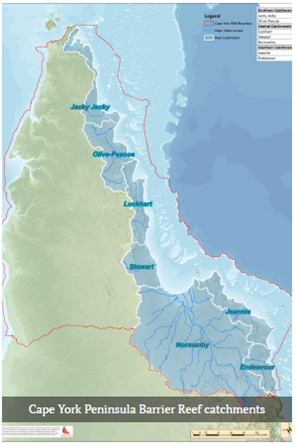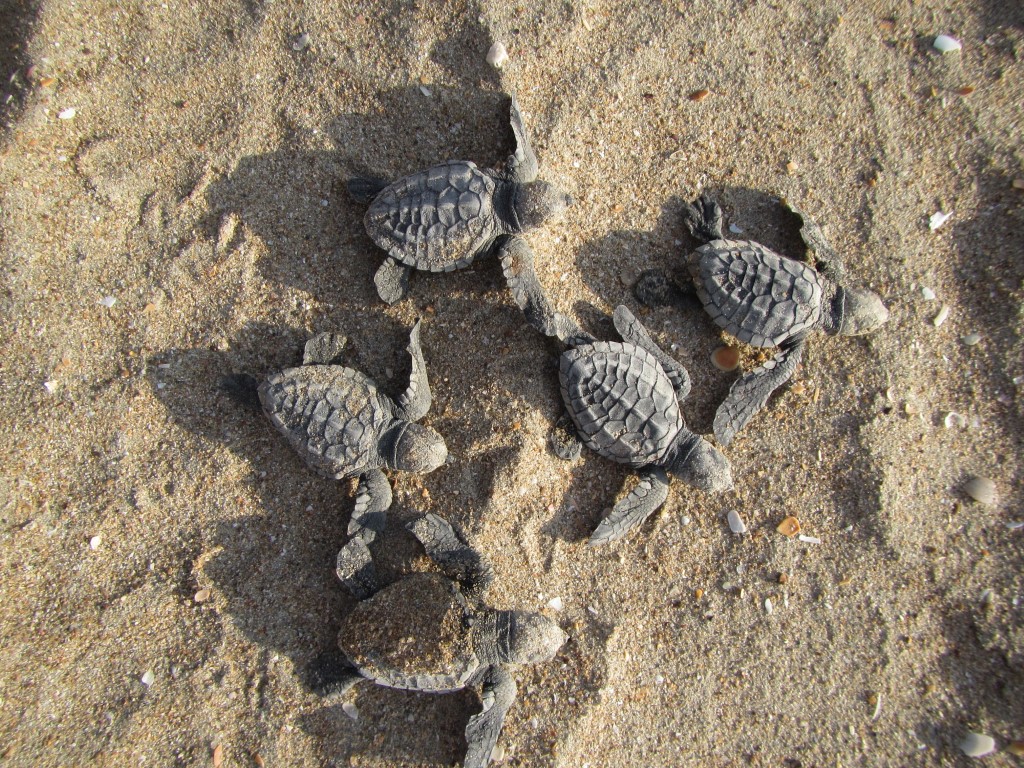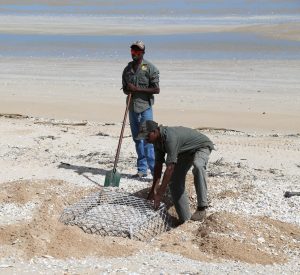The National Feral Pig Action Plan
Cape York Coastal Catchments, Far North Queensland
This demonstration site covers coastal ecosystems on both the Western and Eastern Cape York in far north Queensland.
This site has two key components, coordinated through Cape York NRM:
- Protection of turtle nests from predation of feral pigs (Western Cape Turtle Threat Abatement Alliance (WCTTAA))
- Protecting coastal ecosystems on eastern Cape York (Catchment to Coral project)


What's been achieved
- In areas where nest predation rates by pigs were estimated at being greater than 90% in 2015, prior to intensive predator control efforts, the average predation rate in 2021 was less than 10% in the western Cape. A target nest predation rate of less than 30% is the maximum allowable clutch loss required for population sustainability.
- A total of 2,693 feral pigs were removed by Rangers across the western Cape region in 2021.
- 937 pigs were controlled during an aerial control program conducted along coastal areas of eastern Cape York in November and December 2021, which was during the early part of the marine turtle nesting season.
Background of Program
The WCTTAA is a partnership of six Indigenous Ranger groups from Pormpuraaw, Napranum, Mapoon, Northern Peninsula Area, Kowanyama, and most recently, Aak Puul Ngantum, who are working together, at a regional coordination scale, to protect threatened and endangered marine turtles along the western coast of Cape York. The alliance was formally established in 2013.
The management strategy adopted by WCTTAA has been to continually assess and adapt predator control activities to build on results from the previous year and identify approaches that are as cost-effective as possible. The success of the Western Cape program is measured by the survival rate of turtle nests on the target beaches.
The western Cape York provides important nesting habitat for:
– Queensland’s largest nesting population of the endemic and vulnerable flatback turtle (Natator depressus)
– Queensland’s entire nesting population of the endangered olive ridley turtle (Lepidochelys olivacea)
– Regionally significant nesting population of the endangered hawksbill turtle (Eretmochelys imbricata).
Through this program, the Rangers aim to build capacity within their groups to conduct the work. The WCTTAA Coordinator supports the Ranger groups with annual planning, reviewing predation data, and location of predators relative to the turtle nesting locations.
Annually, all of the Alliance groups meet together in person to share knowledge and discuss approaches, challenges, and outcomes achieved.
More details from their program can be found at Western Cape Turtle Threat Abatement Alliance.
The Catchments to Coral—Great Barrier Reef Coastal Ecosystems and species protection project on eastern Cape York is funded through the Australian Government’s Reef Trust from 2021 to 2023.
Over 80% of the coastal ecosystems of eastern Cape York are either Aboriginal freehold or Cape York Peninsula Aboriginal Land, jointly managed by Queensland Parks and Wildlife Service. Capability and capacity building of Indigenous land managers is a key focus of this program. Cape York Indigenous land managers and communities are being funded through this program to protect the high ecological catchment and coastal values.
Adaptive feral pig management strategies and monitoring systems that have been developed, trialled, and successfully used by Indigenous Rangers on the western Cape to reduce turtle nest predation are being applied on the eastern Cape.
Details of the projects being conducted as part of the Catchment to Coral program can be found at Cape York NRM’s Catchment to Coral.
The mission of the WCTTAA is to be ‘a partnership of on ground land and sea owners and managers, formed to set priorities, seek solutions and share knowledge to maximise the use of resources for coastal management on Western Cape York’.
The WCTTAA seeks to efficiently manage threats to coastal habitats and enhance opportunities for these nesting marine turtle populations from the Mitchell River to Pajinka.

This program aims to improve the health and resilience of coastal habitats within the Great Barrier Reef catchments of eastern Cape York by protecting fragile coastal ecosystems, wetlands and floodplains, coastal vegetation and potential turtle nesting beaches.
The Catchments to Coral project, funded by the Australian Government’s Reef Trust, commenced in July 2021 and is due to be completed in June 2023.
The objectives of this site are to replicate the establishment of a network of the groups/ organisations/ individuals conducting feral pig management activities on Country in eastern Cape York, as implemented on western Cape York. The Catchments to Coral project will support and coordinate efforts of Indigenous rangers to improve efficiency and effectiveness of feral pig management activities, and share and distribute resources to priority areas.
Who's involved?
The Indigenous land and sea managers involved in WCTTAA are:
- Apudthama Rangers, Northern Peninsula Area Regional Council
- Kowanyama Rangers, Kowanyama Aboriginal Shire Council
- Mapoon Land and Sea Rangers, Mapoon Aboriginal Shire Council
- Nanum Wungthim Rangers, Naprunum Aboriginal Shire Council
- Pormpuraaw Land and Sea Rangers, Pormpuraaw Aboriginal Shire Council
- Aak Puul Ngantum
Activities being conducted
Aerial shooting, trapping, ground shooting, nest protection and nest monitoring are all undertaken to manage the threat of feral pigs on native turtle populations and coastal ecosystems.
WCTTAA members coordinate the timing of their aerial culls on Western Cape York to share the costs of conducting aerial shooting along this remote coastline. These aerial programs are usually run twice a year, before and after peak turtle nesting season.
Aerial pig control along the eastern Cape York coastline between Cape Melville to the south and Escape River in the north are conducted twice a year, before and during peak turtle nesting season. The aerial control program targets pigs foraging along beaches at dawn and dusk, as well as those inhabiting adjacent wetlands and sensitive vegetation communities during the day.
WCTTAA Indigenous Rangers constantly manage the target beaches to control predators preying on nesting sites, with feral pigs, dogs and goannas being the main predatory species.
A target nest predation rate of less than 30% is the maximum allowable clutch loss required for population sustainability.
The presence of rangers on beaches and the installation of purpose-built nest protection cages contributes to the reduction in predation and increased turtle hatchings.
During 2021, 3,698 turtle nests were monitored.

Pormpuraaw rangers installing a turtle cage, photo credit Lyndal Scobell (Cape York NRM)
There are many learnings for other management groups from the innovative approaches being used by Indigenous Rangers to collect, report and use data to monitor outcomes on protected assets and values.
These include the technology solutions developed through National Environmental Science Program funding, in partnership with Aak Puul Ngantum and Kalan Enterprises, in the Archer River basin to enable Indigenous Rangers to easily measure and report on the impact of their management actions to Traditional Owners and to funding agencies of land management programs.
Funding
WCTTAA is supported by Cape York NRM, with funding from the Nest to Ocean Turtle Protection Program, a joint initiative of the Australian and Queensland Governments.
The Catchments to Coral—Great Barrier Reef Coastal Ecosystems and species protection project on Cape York is funded by the Australian Government’s Reef Trust. It commenced in July 2021 with funding currently to June 2023.
In the media
Turtle nests benefit from work of ranger programs Cape York Weekly, pg 3, 31 January 2022
Shell be right! Cape York rangers saving baby turtles from feral pigs and 4WDs (theqldr.com.au) The Queenslander, 7 February 2022
Battlelines drawn against weeds and pigs- Cape York Natural Resource Management
‘One in a Thousand’ documentary released– Cape York Natural Resource Management
LandsCape enewsletter page 3-13, June 2022
Further Information
NFPAP feature articles
Feral pig control: the key to turtle nest protection – February 2022 NFPAP newsletter
New measures for Eastern Cape York bring excellent results- Cape York Coastal Catchments demonstration site – September 2022
Official websites
Catchment to Coral- Cape York NRM
Western Cape Turtle Threat Abatement Alliance- Cape York NRM
Apudthama Rangers, Northern Peninsula Area Regional Council
Kowanyama Rangers, Kowanyama Aboriginal Shire Council
Mapoon Land and Sea Rangers, Mapoon Aboriginal Shire Council
Nanum Wungthim Rangers, Naprunum Aboriginal Shire Council
Pormpuraaw Land and Sea Rangers, Pormpuraaw Aboriginal Shire Council
Contact
David Preece, Catchments to Coral Coordinator david.preece@capeyorknrm.com.au
Manuela Fischer, Biodiversity Project Officer – Western Cape Turtle Threat Abatement Alliance Coordinator, manuela.fischer@capeyorknrm.com.au
Phone Cape York NRM on 1300 132 262
Figures, photos and maps have been supplied by Cape York NRM and WCTTAA members.